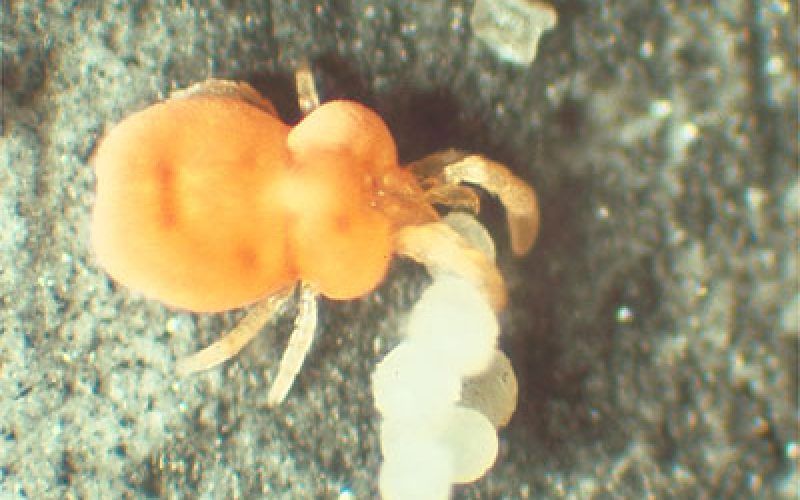
Photo courtsey of Ray Fischer, an entomologist at the University of Arkansas; photo by W.J. Wrenn, University of North Dakota
Chiggers are practically mythical unicorns when it comes to trying to spot them. Folklore and superstition surround these fascinating mites. Here’s the real deal on chigger biology from Ray Fischer, an entomologist at the University of Arkansas.
“Velvet mites, water mites, chiggers, and relatives are mites in a group called Parasitengona,” says Fischer. “The larvae of one group of Parasitengona exploits vertebrates (that includes us) instead of arthropods. We call these chiggers.” There are two families of chiggers: Leeuwenhoekiidae and Trombiculidae, with more than 2,000 species of chiggers worldwide. In Missouri and Arkansas, there are at least 19 discovered species of trombiculid and four species of leeuwenhoekiids. Confusing chiggers with bird mites like Ornithonyssus bursa has some people imagining chiggers as a non-native introduced species which doesn’t derive much nutrition from human hosts and eventually dies, having evolved to prey on poultry. Chiggers, however, are native and humans are a good host species.
Fischer explains that chigger biology is a marvel, with adults having lost the connection between their foregut and hindgut. “When they eat something it travels to a dead end. Over time they accumulate more and more concentrated waste in one of these dead-end gut pouches. The pouch becomes so full that it puts pressure on the animal’s back and eventually pops outside of the body wall! When this happens, the chigger flexes back muscles that pinch off the part of the gut that is extruded, and the body wall heals. This is called schizeckenosy. We can actually age chigger adults by how many scars they have on their backs from schizeckenous events.”
Chigger larvae are to blame for our itching. Adult chiggers are rarely encountered, since they live as furry predators underground. The larvae of most chigger species are active from about June through October. Most chiggers are host generalists, and can feed on mice, rabbits, raccoons, birds, bats, lizards, snakes, deer and more. But chiggers can be habitat specialists, found only in restricted habitats like glades, forests, and tall grasses.
Contrary to legend, chiggers can’t embed in our skin. “Chiggers are strict ectoparasites. Their mouthparts (chelicerae) are short and cannot penetrate the thick skin of most vertebrates… so they make a hole through the dermal layers with a dissolving agent in their saliva and create a hardened straw to make sure the hole doesn’t close up. This straw, called a stylostome, causes the itchy allergic reaction. By the time your body has reacted to the stylostome enough for you to notice, the mite is long gone.” It takes approximately 30 minutes to create the stylostome, giving us a short window of time to remove the mite. Prevention is key, and includes avoiding grassy areas, wearing repellants on shoes and pants (even tucking your pants into your socks, which also discourages tick bites) and frequently wiping down your legs and feet with wet wipes or water from a stream.
• • •
Ripples is an emerging online educational center that teaches a holistic approach to making a difference. Follow our journey to live sustainably and make ripples with our lifestyle at: www.RipplesBlog.org.










